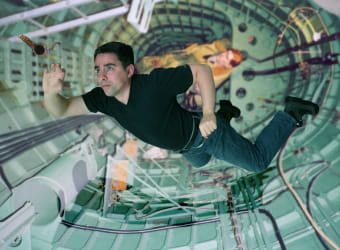Perhaps it is a law of attraction, but we are constantly looking for the next way to defy gravity. It's as if our whole being craves that sense of freedom we feel when we are not weighed down. Lazily suspended in the Dead Sea, soaring in space, flying in planes – and then also jumping out of them. Swings, trampolines, scuba diving – all in some way give us that sense of weightlessness and the liberating feeling that comes with it. Even Archimedes had his eureka moment while floating in a bathtub.
The Wright brothers are widely regarded as the pioneers of flight. But to be very technical, they are credited with the first 'manned, powered, heavier-than-air and (to some degree) controlled' flight. The Montgolfier brothers engineered the first hot air balloon flights in 1783, with a chemistry and physics teacher onboard as the first passenger (revenge by any chance?). The first powered flight was Henri Giffard's steam-powered airship in 1852.
Humankind has been defying gravity for thousands of years, experimenting not only in getting ourselves off the ground, but also the objects around us. As magnetic levitation (maglev) technology enables our trains to glide quickly, quietly and safely without wheels and engines: What other possibilities can our cities unlock if we combine engineering with 'magic' and make everything float? Could we escape the burden of heaviness if we suspend buildings or entire cities in thin air?
Rising to the challenge
The building of superstructures is one massive gravity-defying exercise, with the most fascinating example probably being the Great Pyramid of Giza. Even in this technologically advanced era, we are still scratching our heads as to the unknown, ancient techniques used in producing the jaw-dropping monument that still stands after nearly 4600 years.
Generation after generation has tried to figure out how it was made and one of the many theories suggests that it was acoustic levitation that made it happen. While there was no direct evidence pointing to this, the pyramids' extraordinary acoustic elements indicate that the Egyptians knew a great deal about sound and "how it could be used to produce powerful effects – possibly including levitation."
Then there's the mysterious construction of Coral Castle. It has been compared to the pyramids and Stonehenge, but it had only one builder – a 45 kilogram, 1.5 metres-tall Latvian man who set out to prove to the world, and the woman who left him at the altar, that he could do something great. Edward Leedskalnin single-handedly moved 30-ton blocks, simply explaining that he used elementary leverage and gravity in the way the Egyptians used to construct the pyramids. He also hinted at magnetism and electricity.
Safe and afloat
 Fast forwarding to the 21st century, technology firm Arx Pax is developing Magnetic Field Architecture (MFA), a technology that is based on Lenz's Law to control electromagnetic energy to make objects hover.
Fast forwarding to the 21st century, technology firm Arx Pax is developing Magnetic Field Architecture (MFA), a technology that is based on Lenz's Law to control electromagnetic energy to make objects hover.
While they used this technology to produce the Hendo Hoverboard, their real ambition is to levitate buildings to produce sustainable structures that can survive earthquakes and other natural disasters.
"As an architect, I have an obligation to protect people and property from natural disasters," says co-founder Greg Henderson. "We've had people reaching out to us from the transportation industry, from entertainment, from recreation, from education, from seismic isolation. It's difficult to comprehend how the rules change when you no longer have to touch the ground."
The Japanese are already using the idea of floating buildings by using air to lift buildings in seismic events. By levitating buildings a couple of centimetres above the ground, loss of life will be prevented, together with helping solve the problems of mass evacuation and the emotional and economic toll of rebuilding a shattered habitat.
While a maglev building would remain intact in an earthquake, it would still need to be restrained so that it simply doesn't 'float away' into the ether. In order to keep the building from 'floating away', discrete exoskeletal facade bracing could be utilised to restrain the building.
With the uprising of Mass Engineered Timber (MET), Cross Laminated Timber (CLT) could be used with magnetic strips glued in between its panels, and with a big magnet buried in the ground underneath, you're set to take off with the flick of a switch.
However, the biggest constraint currently is the amount of energy maglev buildings will require. But in a world of fusion, fission and perfect conductors, who knows?
Head in the clouds
With the freedom from gravity comes the freedom of form. Just imagine if we don't have to encumber design with columns, and when we are no longer restrained by the general rules of physics and engineering… we could draw anything and make it happen.
The architectural innovation in building design would be limitless. Real estate would be thrilled with completely unobstructed views. Such designs would need maglev elevators, which ThyssenKrupp in Germany is already implementing in a trial building. These elevators are free to travel horizontally and vertically, eradicating any height or design limitations inside a building with wonderful curves.
Spurned love. A royal commission. Preservation of life. Whatever our motive for the next groundbreaking (or ground-repelling) structure, maglev technology might just be what we need. University professors have already bought into the idea and have entered into partnerships to investigate the possibilities.
It is said that the Britannia Bridge engineer, Robert Stephenson, received some flak from his fellow engineers who told him he raised all kinds of difficulties with the project. "Yes," he replied, "I raise them so that I may solve them."
So, next time you sit around a table with your colleagues, struggling to find a solution to a client's impossible brief and total disregard for Newton, try free-falling headlong into a sea of possibilities and sweep them right off their feet.






